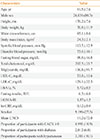Abstract
Background
Methods
Results
Figures and Tables
 | Fig. 1Comparison of the (A) mean values of coronary artery calcium score (CACS) and (B) the proportion of subjects with CACS >0 among the groups divided by body mass index (BMI). ANOVA, analysis of variance. |
 | Fig. 2Comparison of the (A) mean values of coronary artery calcium score (CACS) and (B) the proportion of subjects with CACS >0 among the groups divided by body mass index (BMI) and waist circumference (WC). Group I: BMI <23 kg/m2 and WC <90 cm in men, <85 cm in women; Group II: BMI <23 kg/m2 and WC ≥90 cm in men, ≥85 cm in women; Group III: BMI 23 to 25 kg/m2 and WC <90 cm in men, <85 cm in women; Group IV: BMI 23 to 25 kg/m2 and WC ≥90 cm in men, ≥85 cm in women; Group V: BMI >25 kg/m2 and WC <90 cm in men, <85 cm in women; Group VI: BMI >25 kg/m2 and WC ≥90 cm in men, ≥85 cm in women. ANOVA, analysis of variance. a,b,cGroups with different letters denote significant differences between the groups in the post hoc analysis. |
Table 1
General Characteristics of the Participants (n=33,432)

Values are expressed as mean±SD or number (%).
HDL-C, high density lipoprotein cholesterol; LDL-C, low density lipoprotein cholesterol; HbA1c, glycated hemoglobin; HOMA-IR, homeostasis model assessment index-insulin resistance; hs-CRP, high-sensitivity C-reactive protein; CACS, coronary artery calcium score.
Table 2
Comparison of the Metabolic Variables according to Body Mass Index (n=33,432)

Values are expressed as mean±SD or number (%).
WC, waist circumference; BMI, body mass index; SBP, systolic blood pressure; DBP, diastolic blood pressure; FBS, fasting blood sugar; TC, total cholesterol; TG, triglyceride; HDL-C, high density lipoprotein cholesterol; LDL-C, low density lipoprotein cholesterol; HbA1c, glycated hemoglobin; HOMA-IR, homeostasis model assessment index-insulin resistance; hs-CRP, high-sensitivity C-reactive protein; CACS, coronary artery calcium score.
aAll mean values are significantly different among the three groups in the post hoc analyses.
Table 3
Logistic Regression Analysis with the Presence of Coronary Artery Calcification as the Dependent Variable according to the Groups Divided by Body Mass Index and Waist Circumference

OR, odds ratio; CI, confidence interval; BMI, body mass index; WC, waist circumference.
aThe factors adjusted are age, gender, total cholesterol, high density lipoprotein cholesterol, presence of diabetes, fasting blood glucose, smoking status, systolic blood pressure, homeostasis model assessment index-insulin resistance, and high-sensitivity C-reactive protein; bGroup I: BMI <23 kg/m2 and WC <90 cm in men, <85 cm in women; cGroup II: BMI <23 kg/m2 and WC ≥90 cm in men, ≥85 cm in women; dGroup III: BMI 23–25 kg/m2 and WC <90 cm in men, <85 cm in women; eGroup IV: BMI 23–25 kg/m2 and WC ≥90 cm in men, ≥85 cm in women; fGroup V: BMI >25 kg/m2 and WC <90 cm in men, <85 cm in women; gGroup VI: BMI >25 kg/m2 and WC ≥ 90 cm in men, ≥ 85 cm in women.




 PDF
PDF ePub
ePub Citation
Citation Print
Print



 XML Download
XML Download